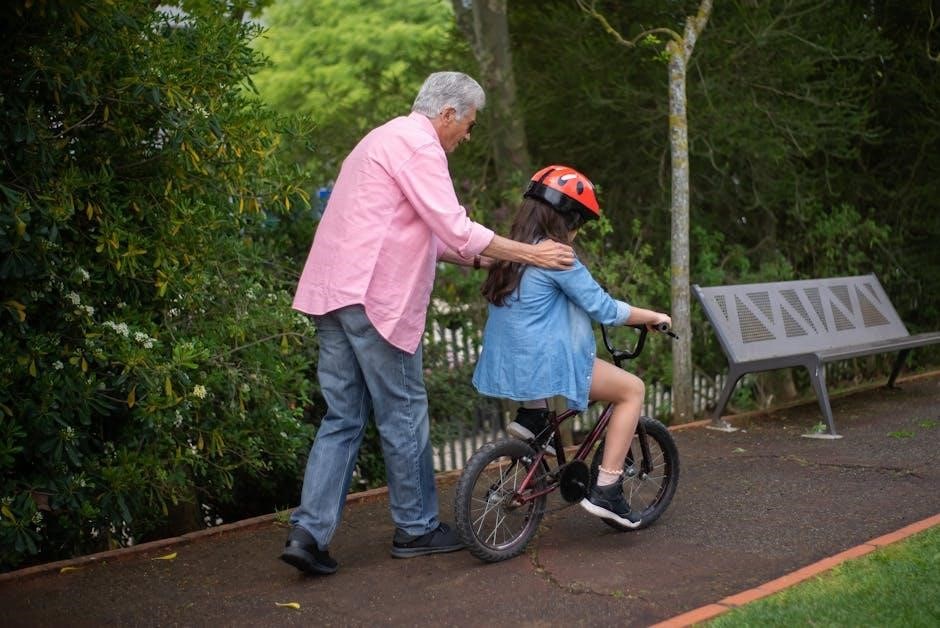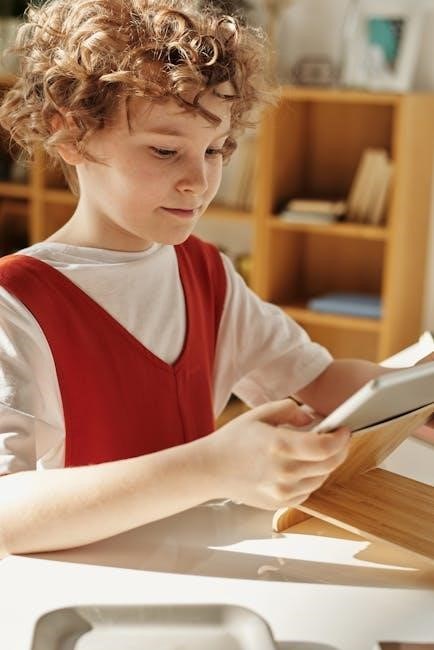
Lesson plans for 1-2 year olds focus on early learning through play, sensory exploration, and social interaction. These plans are designed to be flexible, adapting to the unique needs and developmental stages of young children. They incorporate activities that promote cognitive, motor, and emotional growth, ensuring a balance between structure and spontaneity. Whether in daycare or in-home settings, these plans provide a foundation for curiosity, creativity, and skill-building in a nurturing environment.
Importance of Early Learning
Early learning is crucial for 1-2 year olds, as it lays the foundation for cognitive, emotional, and social development. During this stage, children begin to explore their environment, develop motor skills, and build language abilities. Structured lesson plans provide a framework for consistent learning opportunities, fostering curiosity and creativity. These plans also support the development of problem-solving skills and emotional intelligence, which are essential for future academic and personal success. By engaging in age-appropriate activities, young children build confidence and a love for learning that lasts a lifetime.
Structure and Flexibility in Lesson Planning
Lesson plans for 1-2 year olds require a balance of structure and flexibility. A structured framework ensures consistency in daily routines, such as greeting activities, playtime, and snack times, which help young children feel secure. However, flexibility is equally important, allowing educators to adapt activities based on the children’s interests and energy levels. This approach supports spontaneous learning moments and accommodates individual developmental needs. By blending structure and flexibility, caregivers create an engaging and adaptive learning environment that fosters growth and exploration for toddlers.

Daily Lesson Plan Structure
Daily lesson plans for 1-2 year olds include structured routines like greetings, activity stations, snack times, and outdoor play, fostering predictable schedules while encouraging exploration and growth.

Greeting and Morning Routine
A consistent morning routine is essential for young children, providing a sense of security and structure. Begin with a warm greeting to welcome each child and their parents, fostering a sense of belonging. Incorporate simple songs, rhymes, or movement activities to engage little ones and stimulate their senses. This routine also introduces basic social skills, such as waving, sharing, and using greetings like “hello” and “good morning.” Transition smoothly into the day with a predictable sequence, helping children adjust and feel ready for upcoming activities.
Activity Stations and Play-Based Learning
Activity stations and play-based learning are cornerstone elements in lesson plans for 1-2 year olds. These stations are designed to encourage exploration and hands-on learning through interactive and engaging activities. Examples include art stations with crayons and paper, building blocks for motor skills, and sensory bins filled with textures like rice or sand. Each station fosters curiosity, creativity, and problem-solving abilities while catering to individual interests. Caregivers can rotate children through stations to ensure varied experiences, promoting a balanced approach to early childhood development and keeping little ones captivated and eager to learn.
Snack and Meal Times as Learning Opportunities
Snack and meal times provide valuable learning opportunities for 1-2 year olds. These moments encourage social interaction, fine motor skills, and independence. Caregivers can use this time to teach vocabulary related to food, shapes, and colors. Simple discussions about preferences or textures can foster language development. Additionally, practicing self-feeding with soft utensils or fingers enhances coordination. A calm and encouraging environment during meals helps children develop patience and self-confidence. These routines are not just about nutrition but also about fostering essential life skills and social-emotional growth in a natural, engaging way.

Weekly Lesson Plan Themes
Weekly lesson plan themes provide a structured, engaging approach to learning. Themes are flexible, adapting to children’s interests and needs. Integrated activities like art, music, and storytelling foster exploration and cognitive and social development.
Seasonal and Holiday-Themed Activities
Seasonal and holiday-themed activities bring excitement and engagement to young learners. Decorating eggs for Easter, making snowflakes in winter, or creating Halloween costumes sparks creativity. These activities align with developmental milestones, fostering fine motor skills through crafts and encouraging social interaction during group celebrations. Music, stories, and sensory play tied to holidays promote cultural awareness and curiosity. Adaptations, like using non-toxic materials or simplified tasks, ensure safety and inclusivity for 1-2 year olds. These themed experiences make learning fun and memorable, while connecting with families’ traditions and values.
Introducing the alphabet and numbers to 1-2 year olds focuses on playful, interactive learning. Use songs, rhymes, and visual aids like posters or letter toys to spark curiosity. Simple activities, such as tracing letters with fingers or counting blocks, build foundational skills. Keep sessions short and engaging, with repetition to reinforce recognition. Incorporate tactile experiences, like playdough letter molds or number puzzles, to engage little hands. Relate letters and numbers to their daily lives, such as identifying letters in their name or counting during snack time. This early exposure fosters a love for learning and sets the stage for future academic success.
Sensory Play and Exploration
Sensory play is vital for 1-2 year olds, fostering exploration and development through touch, sight, sound, smell, and taste. Activities like playdough, sand, water, and rice encourage tactile experiences. Use safe, non-toxic materials to create engaging setups, such as sensory bins with hidden toys; These activities enhance fine motor skills, hand-eye coordination, and creativity. Supervise closely to ensure safety and guide discovery. Sensory play also introduces concepts like texture, color, and cause-and-effect, laying a foundation for curiosity and independent learning. Rotate materials regularly to maintain interest and encourage new experiences.

Motor Skill Development Activities
Activities focusing on fine and gross motor skills, such as drawing, stacking, and movement games, help 1-2 year olds build coordination, balance, and independence through play-based learning.
Fine Motor Skills: Drawing and Puzzles

Fine motor skills are foundational for young children, enhancing hand-eye coordination and finger dexterity. Activities like drawing with crayons, completing large-piece puzzles, and playdough molding encourage precision and control. These tasks build independence and creativity, preparing children for writing and problem-solving. Simple, age-appropriate puzzles and stacking toys also strengthen these skills; Caregivers should provide materials suited to their developmental stage and offer patience and encouragement as they explore and learn through play.
Gross Motor Skills: Music and Movement
Gross motor skills are vital for physical development, involving large muscle groups. Music and movement activities, like dancing, marching, and clapping, encourage coordination and balance. Action songs with instruments, such as tambourines or maracas, engage children and promote rhythm awareness. Simple obstacle courses and bubble play also foster active exploration. These activities strengthen overall physical fitness and confidence, preparing children for more complex movements. Ensure spaces are safe and encourage participation, adapting activities to suit individual energy levels and abilities.
Outdoor Play and Physical Development
Outdoor play is essential for physical development, offering opportunities to explore nature and engage in active experiences. Activities like running, climbing, and jumping enhance strength and coordination. Exposure to natural elements, such as leaves, sand, and water, sparks curiosity and creativity. Supervised play in safe, open spaces fosters independence and confidence. Regular outdoor time improves balance, agility, and overall physical fitness, while also encouraging social interaction and teamwork through games like tag or ball play.
Social-Emotional Learning
Social-emotional learning supports toddlers in recognizing and managing emotions, developing empathy, and building relationships. Playful interactions and group activities foster cooperation and self-awareness, laying the foundation for lifelong social skills.
Sharing and Cooperation
Encouraging sharing and cooperation helps toddlers develop essential social skills. Simple activities like passing toys, using timers, and praising kind actions foster a sense of community. Group play with shared materials, such as blocks or crayons, teaches turn-taking and collaboration. Caregivers can model sharing and use positive reinforcement to promote positive interactions. These practices help young children understand boundaries, empathy, and the value of working together, laying the groundwork for healthy relationships and social harmony.
Emotional Awareness and Expression
Helping toddlers recognize and express emotions is crucial for their social-emotional growth. Use simple, relatable language to label feelings like “happy,” “sad,” or “angry.” Incorporate activities such as emotion-themed books, facial expression mirrors, and art projects. Encourage children to connect their experiences with emotions, like discussing feelings during transitions. Role-playing and music also help them explore and communicate emotions effectively. These practices build self-awareness and empathy, fostering healthy emotional development and relationships.

Storytelling and Empathy Building
Storytelling is a powerful tool for fostering empathy in young children. Use simple, engaging stories with familiar themes and characters to help toddlers connect with emotions and experiences. Incorporate puppets or stuffed animals as story characters to make narratives interactive. Encourage children to imagine how characters feel and discuss their emotions. Repetition of stories enhances memory and language skills. End activities by linking stories to children’s lives, asking, “How do you think the character felt?” This builds empathy and understanding of others’ perspectives while nurturing their emotional intelligence.
Cognitive Development
Cognitive development in 1-2 year olds involves enhancing memory, problem-solving, and understanding cause-and-effect. Use age-appropriate activities like sorting, matching, and simple puzzles to stimulate their growing minds.
Color and Shape Recognition
Color and shape recognition activities are essential for cognitive growth in 1-2 year olds. Use large, colorful flashcards to introduce basic shapes like circles, squares, and triangles. Incorporate sensory play with shape sorters, puzzles, and art projects. Sing songs and read books that highlight colors and shapes. Encourage toddlers to identify objects in their environment, such as “Find something red” or “Point to a circle.” These engaging activities help build foundational skills for future academic success and enhance visual perception and memory.
Simple Problem-Solving Activities
Simple problem-solving activities help 1-2 year olds develop critical thinking skills. Use everyday objects, like matching shapes or sorting toys by size. Provide puzzles with few pieces and encourage toddlers to figure out how items fit together. Offer challenges, such as reaching a toy just out of grasp, to promote creativity. These activities strengthen logical thinking and build confidence as children learn to overcome obstacles through trial and error. Celebrate their efforts to foster a positive attitude toward learning and exploration.
Memory and Imitation Games
Memory and imitation games are essential for cognitive growth in 1-2 year olds. Use simple activities like matching pictures or objects, encouraging toddlers to replicate actions. For example, hide a toy and guide them to find it, fostering memory skills. Imitation games, such as clapping rhythms or mimicking animal sounds, enhance creativity and social interaction. These activities not only improve memory but also strengthen the ability to follow instructions and understand cause-and-effect relationships. Keep games short and engaging to maintain their attention and maximize learning opportunities.

Tips for Caregivers and Educators

Tips for Caregivers and Educators
Be flexible, observe interests, and adapt activities. Use positive reinforcement, ensure safety, and provide emotional support. Encourage exploration and offer feedback to tailor lessons effectively.
Creating a Safe and Engaging Environment
Ensure the space is childproofed with soft furniture and non-toxic materials. Organize toys and supplies within easy reach to encourage independence. Maintain a clean, clutter-free area to minimize hazards. Use positive reinforcement to foster a supportive atmosphere. Incorporate natural light, calming colors, and soothing music to create a welcoming setting. Rotate toys regularly to keep children interested and engaged. Supervise activities closely to prevent accidents and provide guidance. A safe and engaging environment promotes curiosity, exploration, and healthy development in young learners.
Adapting Plans for Individual Needs
Recognize that each child has unique abilities, interests, and developmental stages. Assess individual needs to tailor activities accordingly. Incorporate diverse learning styles, such as visual, tactile, or auditory approaches. Be flexible and ready to adjust plans based on children’s responses. Provide additional support or challenges as needed. Allow children to progress at their own pace and explore topics that spark their curiosity. Set personalized goals and celebrate small achievements to foster confidence and growth. Collaboration with parents ensures alignment with each child’s specific requirements and preferences.
Encouraging Parental Involvement
Foster collaboration between educators and parents to enhance learning experiences. Share daily updates and involve parents in activities that align with lesson plans. Provide simple, engaging tasks parents can do at home to reinforce skills. Encourage open communication to understand each child’s preferences and progress. Invite parents to participate in classroom events or share cultural traditions. Offer resources, like activity ideas or educational apps, to support continued learning at home. This partnership strengthens the child’s sense of security and consistency between home and school environments.
Conclude by emphasizing the foundation laid for future learning and the importance of consistent, engaging activities that foster curiosity and skill development in young children daily.

Evaluating Progress and Adjusting Plans
Evaluating progress in 1-2 year olds involves observing developmental milestones, such as improved motor skills or language abilities. Track advancements through photos, notes, and caregiver feedback. Adjust lesson plans to align with individual needs, ensuring activities remain engaging and challenging. Flexibility is key, as young children’s interests and abilities evolve rapidly. Reflect on the effectiveness of each activity and make modifications to foster continued growth. Celebrate small achievements and adapt strategies to support each child’s unique pace of development.
Resources for Further Learning
For further learning, explore educational websites like PBS Kids and NAEYC for age-appropriate activities. Download lesson plan templates and guides from reputable sources. Utilize children’s educational apps like ABCmouse for interactive learning. Check out books on early childhood development for insights. Subscribe to educational blogs and YouTube channels offering practical tips. Join online communities to share ideas with other educators. Access free PDF guides on early learning strategies to enhance your teaching methods. These resources provide valuable tools to create engaging and effective lesson plans for young learners.